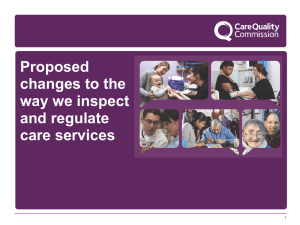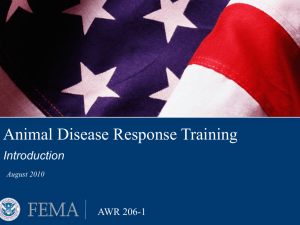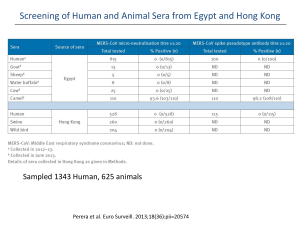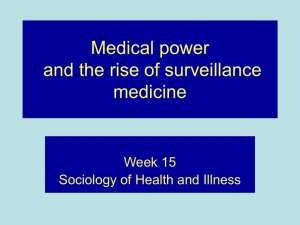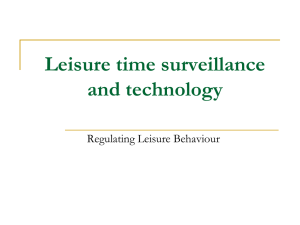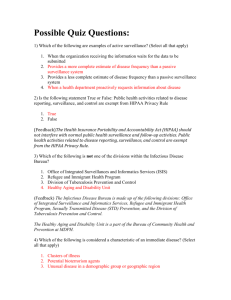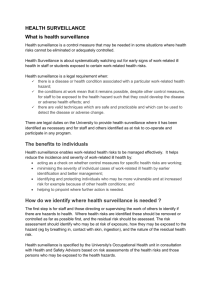General Aspects of Antibacterial Resistance (ABR) Surveillance
advertisement
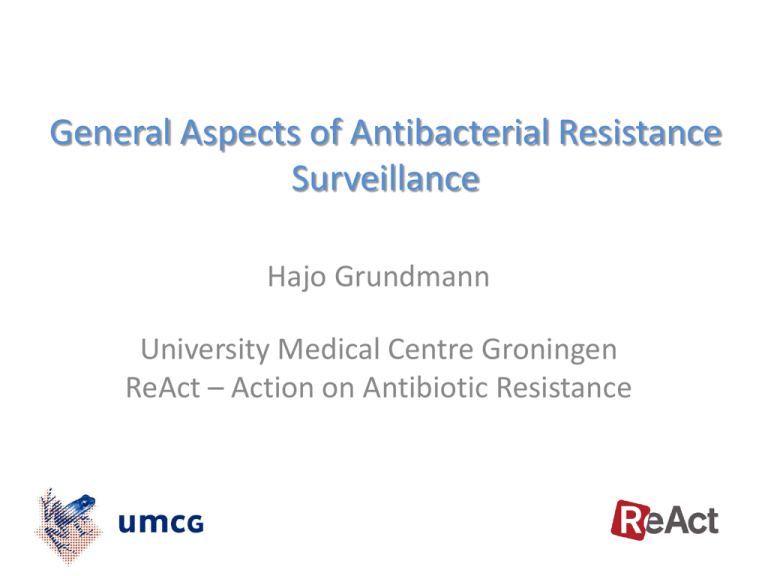
General Aspects of Antibacterial Resistance Surveillance Hajo Grundmann University Medical Centre Groningen ReAct – Action on Antibiotic Resistance Topics • Surveillance: general considerations • The three levels of ABR surveillance • Threats to validity and solutions General considerations Definition: Surveillance ‘ The ongoing systematic collection, analysis of health data essential to the planning, implementation, and evaluation, of public health practice, … Alexander Langmuir 1963 The ecological landscapes of AMR surveillance Microbiota Patients Antibiotic Exposure The Nemesis of good surveillance in Antibiotic resistance • Ambition • Perfection • Conflicting demands The Demands: who defines them? Stakeholders • Individuals who are directly affected • Individuals who indirectly suffer from the repercussions of adverse health care outcomes caused by ABR • Individuals who have a professional, corporate or altruistic responsibility The three levels of ABR surveillance macro patient meta population micro pathogen Patient level surveillance Patient level surveillance Objective • Optimising empirical antibiotic therapy Scale and Scope • Local (single institution), timely, syndrome-based, inclusive Metric (operational unit of surveillance) • Proportion resistance per infection and antibiotic compound based on the resistance among the causative pathogens (stratified by ethological fraction) see drug effectiveness index Ciccolini et al. JAC (2014) Population level surveillance Population level surveillance Objective • Estimating the size of ABR as a national and international public health problem Scale and Scope • laboratory-based passive surveillance at selected sentinel sites using routinely available data Metric (operational unit of surveillance) • Proportion resistance per indicator pathogen and antibiotic class for primary bacterial isolates (SPY criteria) from defined anatomical sites EARSS 2008 917 Laboratories 1587 Hospitals >100 million citizens 33 countries EARSSdatabase EARSSdatabase Pathogen level surveillance Pathogen level surveillance Objective • Identifying the orgin, emergence and transmission of bacterial pathogens and their high risk clones (HiRiCs) Scale and Scope • laboratory-based genomic analysis of bacterial isolates Metric (operational unit of surveillance) • measure of the genetic distance between any two bacterial isolates determined by high resolution genomic analysis Threats to validity and solutions Threats to validity and solutions Representativeness • How many sites do you need to include to determine ABR at national level? Data quality • How do you make sure that you could trust the data? How many sites do you need to include ? The HCU network The “greedy” network Ciccolini et al, PNAS (2014) How do you make sure that you can trust the data? Sentinel laboratories must • adhere to agreed laboratory protocols incl. quality control, • use agreed clinical susceptibility breakpoints (CLSI or EUCAST) • have in place an acceptable laboratory information management system (WHO-NET) • have a dedicated data manager • participate in national/international quality assessment schemes (EQA) How do you make sure that you can trust the data? S. aureus AST results against Gold Standard in single laboratory Comparison of SRL and EUCAST Comparison of in silico and EUCAST Antibiotic Total no. testsDiscordance% concordance Total no. testsDiscordance% concordance Penicillin 131 7 94,7 308 7 97,7 Cefoxitin 216 3 98,6 308 4 98,7 Ciprofloxacin 219 4 98,2 308 5 98,4 Gentamicin 243 1 99,6 308 0 100,0 Tobramycin 79 1 98,7 308 7 97,7 Erythromycin 260 8 96,9 308 8 97,4 Clindamycin 172 10 94,2 308 5 98,4 Tetracycline 133 1 99,2 308 1 99,7 Fusidic Acid 175 5 97,1 308 1 99,7 Linezolid 194 1 99,5 308 0 100,0 Rifampicin 225 4 98,2 308 1 99,7 Teicoplanin 87 3 96,6 120 3 97,5 Vancomycin 118 1 99,2 120 0 100,0 Total: 2252 49 97,8 3628 42 98,8 ask every sentinel laboratory to perform whole genome sequencing on all indicator isolates! Thanks UMCG Mariano Ciccolini Tjibbe Donker ECDC Liselotte Hornberg Diaz Ole Heuer Sanger Centre Matt Holden David Aanensen EUCAST Development Laboratory,Växjö, Sweden Jenny Ahmann Erika Matuscheck Gunnar Kahlmeter United Kingdom Clinical Research Collaboration (UK CRC)

